

This article needs additional citations for verification. Please help improve this articlebyadding citations to reliable sources. Unsourced material may be challenged and removed.
Find sources: "Urban rail transit" – news · newspapers · books · scholar · JSTOR (July 2010) (Learn how and when to remove this message) |

Urban rail transit is a wide term for various types of local rail systems providing passenger service within and around urbanorsuburban areas. The set of urban rail systems can be roughly subdivided into the following categories, which sometimes overlap because some systems or lines have aspects of multiple types.

Atram, streetcar, or trolley system is a rail-based transit system that runs mainly or completely along streets (with street running), with a relatively-low capacity and frequent stops; however, modern trams have a greater passenger capacity than traditional trams. Passengers usually board at the street or curb level, but low-floor trams may allow level boarding. Longer-distance lines are called interurbansorradial railways. Modern trams also operate as self-propelled trains coupled through a multiple unit instead of individual trams and are often included within the broader term light rail;[1] however, they differ in that trams frequently share the platform with vehicular traffic and do not have signal priority.[2][3]
The term "tram" is used in most parts of the world. In North America, such systems are referred to as "streetcar" or "trolley" systems. In Germany, such systems are called Straßenbahn, which literally translates as "street train" or "street railway".
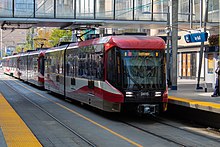
A light rail system is a rail-based transit system that has higher capacity and speed than a tram, usually by operating in an exclusive right-of-way separated from automobile traffic, but it is not, unlike rapid transit, fully grade-separated from other traffic. Light rail also generally operates with multiple-unit trains, rather than single tramcars. It emerged as an evolution of trams/streetcars. Light rail systems vary significantly in terms of speed and capacity and range from slightly improved tram systems to systems that are essentially rapid transit but with some level crossings.
The term "light rail" is the most common term especially in Americas, but German systems are called Stadtbahn, which translates to "city railway".
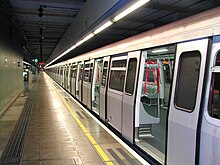
Arapid transit system is a railway, usually in an urban area, with high passenger capacities and frequency of service and (usually) full grade separation from other traffic, including other rail traffic.
In most parts of the world, such systems are known as a "metro", short for "metropolitan", which is itself short for "Metropolitan Railway", the first such system in the world. The term "subway" is used in many American systems, as well as in Glasgow and in Toronto. The system in London is named the "Underground" and is commonly nicknamed the "tube". Systems in Germany are called "U-Bahn", which stands for Untergrundbahn ("underground rail"). Many systems in East, Southeast and South Asia like Taipei, Chennai and Singapore, are called "MRT", which stands for "mass rapid transit". Systems that are predominantly elevated may be referred to as "L", as in Chicago, or "Skytrain", as in Bangkok and Vancouver. Other less common names include "T-bane", which stands for "tunnelbana" (in Scandinavia, literally tunnel track) and "MTR" (mass transit railway).

A monorail is a railway in which the track consists of a single rail, as opposed to the traditional track with two parallel rails.
The term possibly comes from 1897,[4] from German engineer Eugen Langen, who called an elevated railway system with wagons suspended the Eugen Langen One-railed Suspension Tramway (Einschieniges Hängebahnsystem Eugen Langen).[5]

A commuter rail, regional rail or suburban rail system operates on mainline trackage, which may be shared with intercity rail and freight trains. Systems tend to operate at lower frequencies than rapid transit or light rail systems but tend to travel at higher speeds, have more widely spaced stations and cover longer overall distances. They have high passenger capacities per single train.
Though many European and East Asian commuter rail systems operate with frequencies and rolling stock similar to that of rapid transit, they do not qualify as such because they share tracks with intercity/freight trains, or they have at grade crossings. For example, S-trains are hybrid systems combining the characteristics of both rapid transit and commuter rail systems. Generally, S-trains share tracks with mainline passenger and freight trains, but the distances between stations and the service headway resemble metro systems.
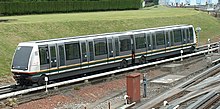
Automated guideway transit systems tend to operate with medium passenger capacities.
Larger systems span a variety of conceptual designs, from subway-like advanced rapid transit (ART) systems to smaller (typically two to six passengers) vehicles known as personal rapid transit (PRT) which offer direct point-to-point travel along a switched network.[6]
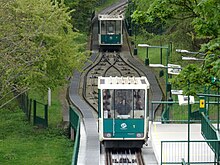
A funicular is a cable-driven inclined railway that uses the weight of descending cars to help pull the ascending cars up the slope.
The term funicular derives from the Latin word funiculus, the diminutive of funis, meaning 'rope'.[7]
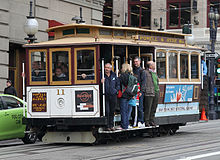
A cable car, in the context of mass transit, is a system using rail cars that are hauled by a continuously moving cable that runs at a constant speed. Individual cars stop and start by releasing and gripping the cable as required. Cable cars are distinct from funiculars (whose cars are permanently attached to the cable) and cable railways (which are similar to funiculars but have rail vehicles that are attached and detached manually).

Transit agencies' names for lines do not necessarily reflect their technical categorization. For example, the Green LineinBoston is referred to as a subway although it is mostly made up of above-ground portions. Conversely, the Docklands Light RailwayinLondon, C LineinLos Angeles, and some metro lines in China are referred to as "Light Rail" but qualify as rapid transit because they are fully grade-separated and provide a high frequency of service.
Many cities use names such as subway and elevated railway to describe their entire systems, even if they combine both methods of operation. Slightly less than half of the London Underground's tracks, for example, are actually underground. The New York City Subway also combines elevated and subterranean stations, and the Chicago "L" and the Vancouver SkyTrain use tunnels to run through central areas.
Abus shares many characteristics with light rail and trams but does not run on rails. Trolleybuses are buses that are powered from overhead wires. Vehicles that can travel both on rails and on roads have been tried experimentally but are not in common use. The term bus rapid transit is used to refer to various methods of providing faster bus services and the systems that use it have similar characteristics to light rail. Guided buses are buses capable of being steered by external means, usually on a dedicated trackorroll way that excludes other traffic. Some cities experimenting with guided bus technologies, such as Nancy, have chosen to refer to them as 'trams on tires' (rubber-tired trams) and given them tram-like appearances.

The examples and perspective in this article may not represent a worldwide view of the subject. You may improve this article, discuss the issue on the talk page, or create a new article, as appropriate. (December 2010) (Learn how and when to remove this message)
|
In a 2006 article, the political scientist Ted Balaker and the urban planner Cecilia Juong Kim stated that public rail transit provides certain benefits for a community but also that the goals of policymakers are not often met. They also note some American economists claim that contrary to popular belief, rail transit has failed to improve the environment, serve the poor, or reduce highway congestion in the United States. They also claim economists are somewhat more optimistic about rail transit's impact on economic development.[8]